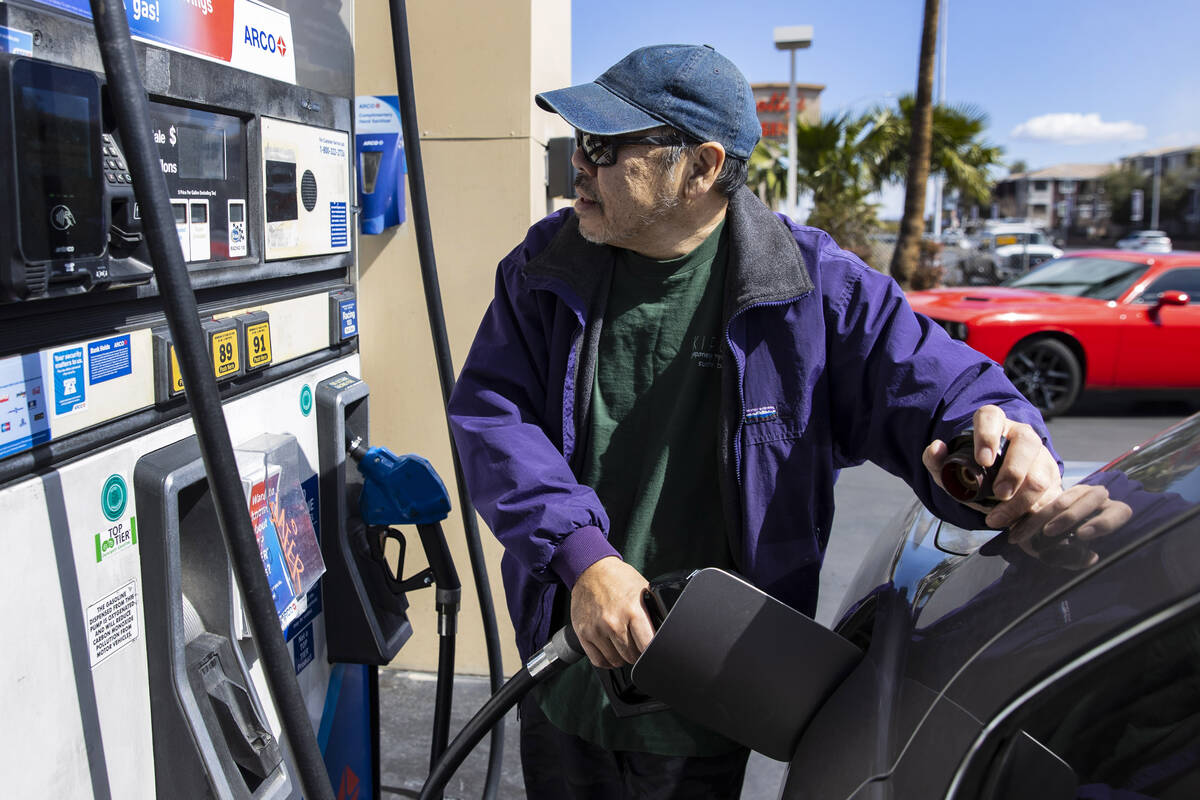Why does Nevada have the second-highest gas prices in the country?
The price of gasoline in Las Vegas continues rising ever upward, setting record after record over the past week — including a new all-time high on Wednesday.
Gas prices in Las Vegas jumped to $4.78 for a gallon of regular unleaded gas on Wednesday, marking the sixth consecutive day a new high mark was set, according to AAA.
Nevada’s statewide average also set an all-time high Wednesday at $4.77 a gallon, which is tied with Hawaii for the second most expensive in the country. Only California has higher average gas prices at $5.53 per gallon, according to AAA.
So why have prices risen so quickly? And why does Nevada have some of the highest prices in the nation?
Primarily, it boils down to supply and demand.
U.S. oil production is just under 12 million barrels a day, 8 percent lower than in 2019, according to CNN. Experts say the industry is unlikely to get back to that pre-pandemic level this year, the network reported, due to a shortage of workers and equipment as well as fresh memories of the pandemic’s early days when oil prices briefly went negative.
A month ago, oil was selling for about $90 a barrel before spiking to close to $130 a barrel. On Wednesday, the benchmark price of a barrel of U.S. crude oil dropped 12 percent to $108.70 amid reports that the United Arab Emirates will urge fellow OPEC members to boost production and ease supply concerns.
“Oil companies don’t set the market prices; people do, by filling up their tanks,” said Patrick De Haan, petroleum analyst for GasBuddy, which tracks gasoline prices around the U.S.
Impact of Russian war
Analysts say that nearly the entire rise of the last week — about 55 cents a gallon nationwide, on average — can be linked to anticipation that eventually western countries would ban Russian crude, further shrinking their already tight supplies.
“The U.S. doesn’t need Russian oil per se, but the world and particularly Europe are dependent on it,” said Tom Kloza, an analyst for the Oil Price Information Service.
According to government figures, the U.S. imported 245 million barrels of oil from Russia last year, or 8 percent of all U.S. oil imports. That is less than the United States imported from Canada or Mexico but more than it took from Saudi Arabia.
But West Coast oil refineries are Russia’s best U.S. customers. Nearly half of Russian oil shipped into the U.S. last year, or close to 100,000 barrels a day, ended up primarily in California, Washington and Hawaii, refinery consultant Andrew Lipow said.
Further complicating the supply outlook: California oil production is down 70 percent from the 1986 peak, Lipow said, and “the prospects for increased drilling in California are slim due to the regulations governing that activity.”
How that affects Nevada
Nevada normally is among the most expensive states for gas, spike or not, because of its reliance on neighboring states to supply fuel to the Silver State. Indeed, Las Vegas’s gasoline largely comes via pipeline from California.
“Given Nevada’s limited refining capacity, it depends a great deal on its neighbors (like California) for gasoline,” said Aldo Vazquez, AAA spokesman. “Higher transportation costs due to limited refining capacity, higher taxes than other states and special specifications for gasoline in Nevada contribute to its higher gas prices.”
The switch to summer grade gas from winter grade also adds to the price as the summer approaches. Summer gas is a slightly higher grade than the winter blend and in turn costs up to 15 cents more per gallon, according to GasBuddy.
The role of gas taxes
As Vazquez said, taxes play a role in gas prices, with Nevadans paying among the nation’s highest.
Nevada has the sixth highest motor fuel tax in the U.S. at 68.88 cents per gallon, or 11 cents more than the U.S. national average, according to the American Petroleum Institute. The only states that have higher gas taxes are New Jersey, Hawaii, Pennsylvania, Illinois and California.
In Clark County, a total of 67.9 cents is collected per gallon of gas, according to the Regional Transportation Commission of Southern Nevada.
Of that total, 15.69 cents per gallon is attributed to Fuel Revenue Indexing, a funding program that ties the motor fuel tax to inflation. The indexing program was approved by voters in 2016 and is slated to increase each year through 2026.
“The maximum it can go up is 4 cents per year and is tied to the producer price index,” said Angela Castro, RTC spokeswoman.
Here’s a breakdown of the gas taxes those who reside in the Las Vegas Valley are paying.
■ 20.79 cents per gallon goes to the RTC;
■ 8.24 cents per gallon goes to Clark County;
■ 20.47 cents is sent to the state;
■ 18.4 cents per gallon goes to the federal government.
All gas tax collected is restricted for use on roadway improvements and maintenance and can’t be used elsewhere. Since 2014, $1.85 billion from gas and sales tax has been distributed to road projects in Southern Nevada.
A proposal sought by Democratic U.S. senators to reduce federal gas taxes won’t bring relief for Nevada residents.
That’s because a state law in place since at least 1973 raises Nevada’s fuel tax by the exact amount of any reduction in federal levies.
No relief in sight
Motorists also aren’t likely to get relief soon from a drop in prices. Normally fuel prices rise in spring and summer, as Americans drive and fly more. Demand could also get a boost as U.S. states and other countries continue to shed their COVID-19 restrictions. Those trends suggest that pump prices are heading higher, with demand continuing to outstrip supply.
“It’s not going to be a good summer for motorists,” De Haan said.
Contact Mick Akers at makers@reviewjournal.com or 702-387-2920. Follow @mickakers on Twitter. The Associated Press and the Los Angeles Times contributed to this story.


















